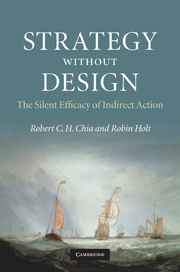Book contents
- Frontmatter
- Contents
- Preface
- Introduction
- 1 Spontaneous order: the roots of strategy emergence
- 2 Economic agency and steps to ecological awareness
- 3 Reconceptualizing agency, self-interest and purposive action
- 4 The ‘practice turn’ in strategy research
- 5 Building and dwelling: two ways of understanding strategy
- 6 Strategy as ‘wayfinding’
- 7 The silent efficacy of indirect action
- Epilogue: Negative capability
- Notes
- Index
6 - Strategy as ‘wayfinding’
Published online by Cambridge University Press: 22 January 2010
- Frontmatter
- Contents
- Preface
- Introduction
- 1 Spontaneous order: the roots of strategy emergence
- 2 Economic agency and steps to ecological awareness
- 3 Reconceptualizing agency, self-interest and purposive action
- 4 The ‘practice turn’ in strategy research
- 5 Building and dwelling: two ways of understanding strategy
- 6 Strategy as ‘wayfinding’
- 7 The silent efficacy of indirect action
- Epilogue: Negative capability
- Notes
- Index
Summary
[W]e know as we go, not before we go (ambulatory knowing)…the world is not ready-made for life to occupy … It is rather laid out along paths of movement… To find one's way is to advance along a line of growth, in a world…whose future configuration can never be fully known.
Tim Ingold, The Perception of the Environment, pp.230–231(emphasis in original)In the previous chapter we identified two distinct modes of engaging with the world strategically, which we termed building and dwelling. In the building mode the agent-strategist is presumed to construct mental representations of the world prior to any practical engagement with it. The dwelling mode of engagement, on the other hand, consists of local adaptations and ingenuity in everyday practical coping, which constitute the kind of micro-strategizing associated with the practice approach to strategy. In acting strategically on an everyday basis, therefore, an agent is acting purposively to deal with immediate concerns at hand but doing so in habituated ways that are consistent with and reinforcing his or her own sense of identity. He or she is also aware, potentially, of the limits of this pragmatic engagement, and of how things might be encountered other than simply as equipment for human ends.
Whereas in the next chapter we develop the sense of strategic limit brought about by dwelling amid things phronetically, in this chapter we begin to develop the dwelling approach by introducing the notion of strategy as a process of wayfinding, in contrast to the conventional idea of strategy-making as a navigational process.
- Type
- Chapter
- Information
- Strategy without DesignThe Silent Efficacy of Indirect Action, pp. 159 - 185Publisher: Cambridge University PressPrint publication year: 2009



